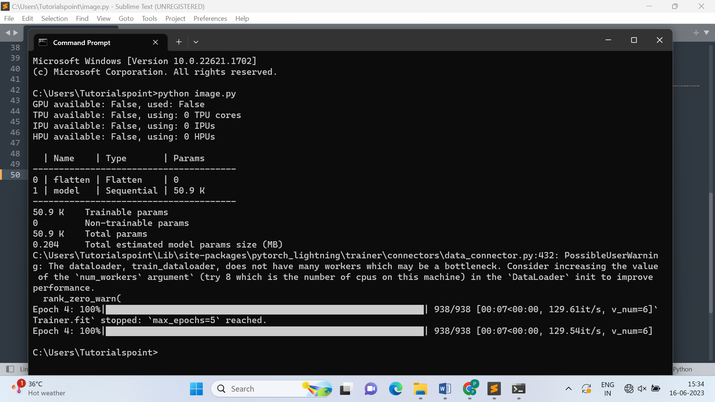
 Data Structure
Data Structure Networking
Networking RDBMS
RDBMS Operating System
Operating System Java
Java MS Excel
MS Excel iOS
iOS HTML
HTML CSS
CSS Android
Android Python
Python C Programming
C Programming C++
C++ C#
C# MongoDB
MongoDB MySQL
MySQL Javascript
Javascript PHP
PHP
- Selected Reading
- UPSC IAS Exams Notes
- Developer's Best Practices
- Questions and Answers
- Effective Resume Writing
- HR Interview Questions
- Computer Glossary
- Who is Who
Training Neural Networks using Pytorch Lightning
Pytorch Lightning which is a very powerful framework simplifies the process of training the neural networks. As we know neural networks have become a fundamental tool for solving problems related to machine larning, howevere training neural networks have become a necessary yet challenging task which requires careful management of models, data and training loops that is why we use PyTorch Lightning
In this article, we will explore what is PyTorch Lightning, how to train neural networks using PyTorch Lightning, its benefits, and various techniques to enhance the training process.
What is PyTorch Lightning?
PyTorch Lightning is a user-friendly Python library that simplifies the training of neural networks. It is designed to make deep learning easier for beginners and experts alike. Instead of getting caught up in complicated code, PyTorch Lightning provides a clear and organized framework for building models.
It takes care of tedious tasks like data loading and training loops, so we can focus on the exciting parts: designing your network architecture and experimenting with different techniques. With PyTorch Lightning, you can accelerate your learning curve and make progress faster.
Benefits of PyTorch Lightning for Training Neural Networks
PyTorch Lightning provides multiple benefits for neural network training ?
It encourages code modularity by breaking down problems or concerns into separate modules, such as model design, data loading, and training loops. This modular approach makes the codebase much easier to debug, comprehend, and maintain.
Pytorch lightning automates a number of common tasks, including distributed training, gradient accumulation, and logging. This allows us to concentrate on the main components of their models rather than on implementation issues.
Steps to Training Neural Networks using Pytorch Lightning
The following is a step-by-step guide on training a neural network with PyTorch Lightning, a framework that simplifies the training process by providing useful abstractions and handling monotonous tasks. We can concentrate on creating our model and processing the data using PyTorch Lightning, while the framework handles the complexities of the training loop and other difficult operations ?
Import all the essential libraries that we will expect to work with neural networks and datasets like light and pytorch_lightning.
We define the structure of our neural network. Our model contains a few layers, each with its specific task in processing the input data and making predictions. The 'forward' method portrays how the information moves through these layers.
Once the model is defined, we continue on to characterizing and carrying out the training step. During preparation, the model gets clumps of information and their separate names. It uses these batches to calculate a loss value and make predictions. This loss value addresses how precise the model's forecasts are. Furthermore, we log the loss number to monitor the model's advancement as it learns.
For improving the performance of our model we will require an optimizer. The optimizer helps the model adjust its internal parameters to achieve better results.
To deal with the whole training process automatically we need to set up the trainer. We will likewise indicate the number of raining epoches, which refers to the number of complete passes through the dataset that our model will undergo during training.
We define an data module to deal with the dataset and set it up for preparing. This module deals with stacking the dataset, in the below program example, the MNIST dataset is utilized, and changing the dataset into tensors that can be handled by our model.
Once we have defined our model, data module, and trainer we make instances of every one of them. These occurrences will be utilized all through the training process.
Finally, we're prepared to begin the training process. We call the 'fit' function for the trainer, which starts the training process. The trainer runs a loop for the predetermined number of epoches.
In every epoch, the model get batches of data, performs the training step (making predictions, calculating the loss, and optimizing the parameters), and rehashes this cycle until the whole dataset has been handled.
Example
import torch
from torch import nn
from torch.utils.data import DataLoader
from torchvision.datasets import MNIST
from torchvision.transforms import ToTensor
import pytorch_lightning as pl
# Define your neural network model
class NeuralNetwork(pl.LightningModule):
def __init__(self):
super(NeuralNetwork, self).__init__()
self.flatten = nn.Flatten()
self.model = nn.Sequential(
nn.Linear(784, 64),
nn.ReLU(),
nn.Linear(64, 10),
)
def forward(self, x):
x = self.flatten(x)
return self.model(x)
def training_step(self, batch, batch_idx):
x, y = batch
y_hat = self.forward(x)
loss = nn.CrossEntropyLoss()(y_hat, y)
self.log("train_loss", loss)
return loss
def configure_optimizers(self):
return torch.optim.Adam(self.parameters(), lr=0.001)
# Create a PyTorch Lightning trainer
trainer = pl.Trainer(max_epochs=5)
# Create a PyTorch Lightning data module
class DataModule(pl.LightningDataModule):
def train_dataloader(self):
return DataLoader(MNIST(root="./data", train=True, transform=ToTensor(), download=True), batch_size=64)
# Create an instance of the data module
data_module = DataModule()
# Create an instance of the neural network model
model = NeuralNetwork()
# Train the model
trainer.fit(model, data_module)
Output

Conclusion
In conclusion, PyTorch Lightning is a powerful framework that simplifies the process of training neural networks. It provides a structured and organized approach to managing data, models, and training loops. By abstracting away the complexities of PyTorch, PyTorch Lightning enables researchers and practitioners to focus on the core aspects of their models. With its ease of use and flexibility, PyTorch Lightning is an excellent choice for both beginners and experienced practitioners in the field of deep learning.

